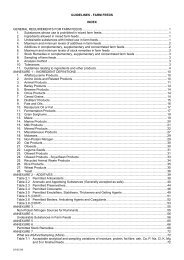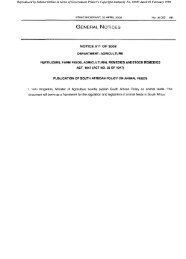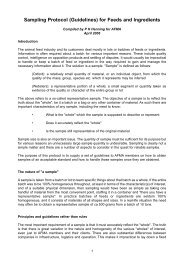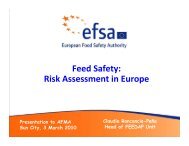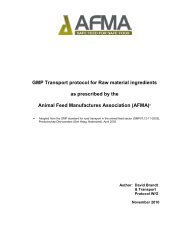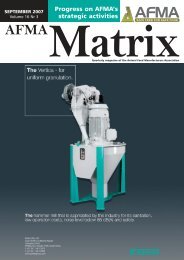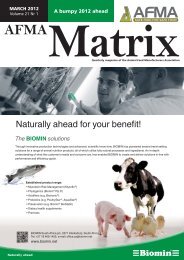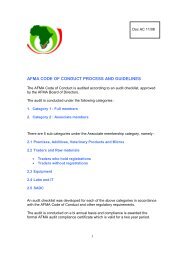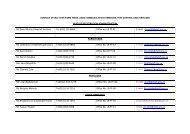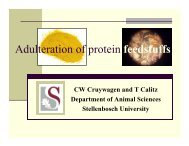Create successful ePaper yourself
Turn your PDF publications into a flip-book with our unique Google optimized e-Paper software.
of both the advisor and the farmer in order<br />
to increase profits. These models are being<br />
used to formulate realistic but challenging<br />
objectives to advance the operation.”<br />
Objectives should therefore be formulated<br />
annually in conjunction with the advisor<br />
and the farm management team and<br />
be revised every three months.<br />
“A good advisor thinks in the same way<br />
about a farming business than the farmer<br />
himself and does not only consider his own<br />
company’s turnover and profit. A technical<br />
advisor who is knowledgeable, looks<br />
after your interests in a responsible way<br />
and conducts his job with passion, is most<br />
probably the right advisor for you. Look for<br />
passion, energy, availability, knowledge,<br />
experience and the ability to set objectives<br />
and achieve them.”<br />
After confirming that the farmer is happy<br />
with his technical advisor, it is time to<br />
turn the focus on the approach the advisor<br />
should take to providing the best service<br />
as efficiently as possible. Eugene Viljoen,<br />
chief operating officer of Meadow Feeds’<br />
central region, has compiled a protocol for<br />
technical advisors.<br />
First visit to a farm<br />
When first visiting a new client, there<br />
is certain paperwork that has to be<br />
completed by the technical advisor.<br />
This includes a credit application<br />
and a farm report, including logistical<br />
information such as the quantities<br />
of feed the farm can manage at one<br />
time, the truck access situation, daily<br />
feed usage as well as delivery times.<br />
The next step is to agree on the<br />
level of involvement of the technical<br />
advisor on the farm. This includes the<br />
frequency of visitations and to what<br />
extent the advisor will be involved<br />
during such a visit. Most feed companies<br />
would set a minimum of one<br />
visit per month per customer to their<br />
advisors.<br />
Key performance responsibilities<br />
Obviously the key performance responsibilities<br />
(KPRs) will cover a very wide range,<br />
but it starts right at home, with basic issues<br />
such as adherence to the company dress<br />
code and code of conduct.<br />
Next in line are data collections and<br />
analysis. In the case of an intensive milk<br />
production operation, for example, this<br />
revolves mainly around analyses of total<br />
mixed rations, where the rations of all<br />
groups of cows have to be analysed at<br />
least every month. In the case of pastures<br />
the next pasture to be grazed should be<br />
analysed per visit. Obviously every species<br />
has its own challenges.<br />
Water analysis is equally important and<br />
chemical and pH analysis should be done<br />
“Technical advisors on<br />
the ground must be<br />
knowledgeable specialists,<br />
able to provide good advice<br />
that is tailor-made for that<br />
specific client, rather than<br />
trying to sell a batch of feed or<br />
products at all costs”<br />
as necessary. Using the right formulation<br />
programmes is the next issue. There are<br />
many programmes available. The main issue<br />
is to apply the programme consistently<br />
and effectively. Fine-tuning the rations<br />
to account for seasonal climatic fluctuations<br />
will increase efficiency, but will also<br />
demand more management inputs. With<br />
the information collected through an onfarm<br />
weather station, rations can be finetuned<br />
with even more precision that could<br />
increase efficiency greatly.<br />
Record-keeping<br />
It is extremely important that meticulous<br />
reports are maintained regarding every<br />
farm visit. This ensures effective continuity<br />
and integrity.<br />
A farm visit should be preceded by<br />
proper preparation. This includes studying<br />
the farmer’s purchase and payment history<br />
over the preceding months, the delivery<br />
history as well as the reports of the previous<br />
visits.<br />
A proper appointment has to be made<br />
and a clearly defined objective set that<br />
should be achieved during the visit. The<br />
visit should be well-structured to ensure<br />
that time and travel is effectively utilised<br />
and that the visit is effective and meaningful.<br />
The visit<br />
A visit should be divided into phases, starting<br />
with a brief discussion of the previous<br />
months’ history, such as the volumes of<br />
feed purchased per month, total volume<br />
of milk/eggs/meat produced, income over<br />
feed cost (IOFC), butter fat and protein<br />
concentration (percentage) as opposed to<br />
butter fat and protein yield (kilogram). This<br />
phase should be concluded with an assessment<br />
of the feeding practice and protocol<br />
of all groups of animals on the farm.<br />
The next phase is an assessment of the<br />
animals:<br />
• Availability of meal/pellets, water<br />
and roughage.<br />
• Assess comfort.<br />
• Overall hygiene.<br />
• Feed intake, especially at weaning.<br />
At the end of the visit, a detailed report<br />
should be written, reflecting critical information<br />
on the main points of discussion,<br />
and production records such as<br />
milk production, egg and meat production.<br />
Record any tasks or expectations<br />
of the client as well as the advisor and<br />
give feedback on diet changes within 24<br />
hours. Other recorded actions must be<br />
completed within seven days of the last<br />
visit and feedback must be provided in<br />
a formal, written form with copies sent<br />
to all the appropriate managers, such as<br />
the sales and technical managers.<br />
Learn to communicate<br />
Because farmers are all individuals with<br />
unique personalities, it would benefit the<br />
technical advisor to study effective communication<br />
with various personality types. Effective<br />
communication forms a significant<br />
part of the task of a technical advisor and<br />
understanding personality types will undoubtedly<br />
benefit the ambitious technical<br />
advisor.<br />
<br />
Client focus<br />
<strong>AFMA</strong> MATRIX ● APRIL <strong>2013</strong> 57



